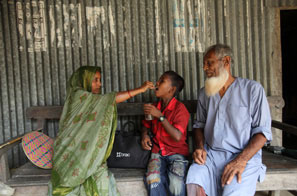
The year 2016 saw a rise in the number of tuberculosis patient detection, child TB patients in particular. Use of upgraded technologies and machines enables health professionals to diagnose more patients with the infection, which has caused the rise in the number. In 2015, a total of 7,984 children were diagnosed with TB, while the number rose to 9,291 in 2016. In percentage account, child TB patient detection in 2016 was 4.3 per cent. In 2015, it was 4 per cent. In 2016 again, the total number of patients including children detected with TB stood at 2,23, 922. Of them 9,700 were multi-drug-resistant (MDR) TB patients.
Experts revealed these at a press conference today on Thursday, organised at the National Press Club on the occasion of World Tuberculosis Day 2017. Every year 24 March is observed as the World TB Day. National TB Control Programme (NTP) under the Directorate General of Health Services (DGHS) of the Ministry of Health and Family Welfare, BRAC and other partner organisations jointly arranged the press conference. The event was organised to share the successes and experiences from the TB control activities as well as the future planning in this regard. This year, the WHO released slogan for the day is 'Unite efforts to leave no one behind'.
NTP line director Dr Rouseli Haq was present as the chief guest at the press conference. Key presentation was delivered by DR-TB chief executive Dr Nazis Arefin Saki.
Deputy World Health Organisation representative Dr Edwin Salvador, national professional officer of WHO in Bangladesh Dr Vikarunnesa Begum, country project director of Management Sciences for Health Dr Oscar Cordon, senior infectious disease adviser of USAID in Bangladesh Dr Charles Lerman and programme head of BRAC TB and Malaria Control Programme Dr Shayla Islam spoke at the event, among others. A press note was also presented by BRAC's senior sector specialist for TB Dr Md Masud Rana.
Referring to the WHO Global TB Report for 2016, the experts said in Bangladesh, every year 45 patients in every one lakh (100 thousand) people die of TB, while 225 new TB patients in every one lakh are diagnosed with the infection.
They also spoke about the successes of TB treatment in Bangladesh, saying 94 per cent patients diagnosed with lung TB with germs in cough get cured.
They also said Bangladesh is ahead of the world in treating MDR-TB patients with 70 per cent success rate, compared with the world average of 52 per cent.
According to the targets Bangladesh government has set, the country will lower the rate of TB-related deaths by 95 per cent and the rate of TB prevalence by 90 per cent by 2035 than that occurred in 2015. To achieve these targets 27 NGOs are working with the government on the lead.
In the keynote Dr Najis Arefin Saki pointed out that the use of upgraded technologies has made it possible to diagnose ever more patients, taking the current rate to 61 per cent. In 2015, the rate of detection was 57 per cent. GO-NGO collaboration brought many commendable successes in TB treatment in the country, although 39 per cent of the patients remain still missing, owing to different factors.
In chief guest’s address Dr Rouseli Haq said ‘Since 1993 NTP has been working successfully, as a result of which we are now able to diagnose 77 lung TB patients with tuberculosis germs in cough out of every 1 lakh people. Out of the diagnosed TB patients 94 per cent are getting cured.’
Dr Shayla Islam said, ‘It is highly necessary now to scale up our operations in the urban areas. High population density in the cities makes TB patient detection somewhat difficult. We are now establishing a network with the private physicians to strengthen the referral system, which we hope will add pace to the whole process.’
Challenges in diagnosis and treatment of the infection that the speakers pointed out are: Shortage of health facilities to give treatment, shortage of staff with required skills, difficulty in giving treatment to floating patients living particularly in urban slums, private facilities not referring TB patients to NTP, insufficient GeneXpert machines to diagnose MDR-TB, lack of access in giving diagnosis and treatment services to people working in garment and other privately owned factories.
The NTP, BRAC and other partners will also organise a parade on 24 March World TB Day in the capital city. The parade will start at 7am at Shahbag to end at the National Press Club.









